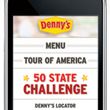By Amy Vale
 Do you order take-out three nights a week on your
smartphone? Have you used your mobile device to locate a nearby restaurant? Do
you often look up a restaurant’s menu while on-the-go? If you answered yes to
any of these, you’re not alone. According to a recent report from eMarketer,
the mass availability of mobile devices is making mobile dining that much more
common among U.S. consumers. In fact, 32 percent of U.S. millenials reported
checking menus on their phones and nearly one-quarter of U.S. smartphone and
tablet users used their mobile devices to order ahead (typically at
quick-service or fast-casual restaurants). Here are three ways for restaurant publishers
and app developers to beef up their monetization strategies.
Do you order take-out three nights a week on your
smartphone? Have you used your mobile device to locate a nearby restaurant? Do
you often look up a restaurant’s menu while on-the-go? If you answered yes to
any of these, you’re not alone. According to a recent report from eMarketer,
the mass availability of mobile devices is making mobile dining that much more
common among U.S. consumers. In fact, 32 percent of U.S. millenials reported
checking menus on their phones and nearly one-quarter of U.S. smartphone and
tablet users used their mobile devices to order ahead (typically at
quick-service or fast-casual restaurants). Here are three ways for restaurant publishers
and app developers to beef up their monetization strategies.
Re-engage beyond
initial “install”
For utility apps that aren’t centered around games and
entertainment, it’s all about re-engaging users (time and time again) past the
initial “install.” That’s where in-app purchases can help make monetization
become much more plausible and a reality for publishers and app developers. A
new Gartner study
reveals that apps where users can buy extra items, levels or services are
expected to reach 30 percent of all apps in 2016 – that’s up from only 5
percent in 2011. And the revenue coming from in-app purchases will grow from 10
percent to 41 percent over the same period. Getting these types of non-gaming
users (i.e. foodies) interested in making in-app purchases is very beneficial –
users are rewarded for their brand and app loyalty, while publishers and app
developers get revenue.
Be relevant and
reward loyalty
This past summer, Denny’s restaurant chain launched its “50State Check-In Challenge” in conjunction with the release of its first
mobile app. But the casual restaurant chain’s goal wasn’t to increase brand
awareness; it was to make the experience relevant and useful for its customers.
If you ask me, Denny’s CMO made a smart decision to design their own app
because they mirrored the app’s user experience and functionality to their
audience – who they are, what devices they use, what types of content matter,
and of course, where they are.
Knowing that not every Denny’s customer may be keen to
embark on this type of eating adventure, the app does a good job of including
both types of customers with loyalty-based prizes and virtual badges. For
example, users who check in to a Denny’s location 10 times will receive 10% off
their checks and 25 check-ins pays off with a free “Pancake Puppies” sundae.
Group check-ins are also rewarded. There’s a simple lesson to be learned here.
A strong user experience breeds loyalty; loyalty drives repeat visits, in-app
purchases and social promotion; all of this leads to a consistent source of
revenue for publishers and app developers.
Location,
location, location
I’ve said this time and time again, but I’ll say it
again. Targeting capabilities are an invaluable tool for publishers and app
developers. When it comes to dining, hungry people are usually on the hunt for
good food, right here and right now. Using geo-location targeting, publishers
and app developers can serve up ads that have location-specific relevance and,
more importantly, can be used immediately. Serving up the right types of ads to
the right users in the right place can have real monetization benefits.
As we head into what I can only assume will be a
food-heavy holiday season, I hope publishers and app developers are being smart
with their monetization strategies. Are there any restaurant and dining apps
that you absolutely love? Do you prefer to use your smartphone or tablet for
on-the-go food activities? Tell us on our Facebook page or share your
favorite (or funniest) mobile food experience on Twitter using the hashtag
#MobileFoodie!

No comments:
Post a Comment